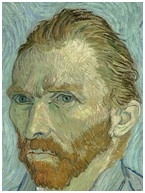|
 |
|
 |
|
|
||
Pablo Picasso - Creativity and Art
Pablo Picasso (1881-1973)
Spanish artist ,born in Málaga (pictured right) Highly prolific (with 43,000 works)
His most famous painting is... Guernica (1937), showing the bombing of the town of Guernica during the Spanish Civil War in 1936.
Why was he so creative?
1. Revolutionary Everything he did (painting, ceramics, pottery and sculpture) was incredibly inventive and original. “Each time I had something to say, I said it in the way I felt was right”, he said. He was a natural rebel, who:
An example of his Blue Period is pictured right - The Greedy Child (Le Gourmet), 1901.
2. Support and learning Picasso learned from: a) his parents His father (also a painter, pictured right)
He also adored his mother. b) other great artists Particularly:
“Bad artists copy. Great artists steal”, he said.
3. Concentration He had the self-discipline to concentrate totally on his painting. Guernica, like all his great paintings, was a result of weeks of intense work. Thinking was very important to his art. “I paint objects as I think them, not as I see them”, he said.
4. Observation and experience He had a wonderful ability to remember things and people. He used this observation and his experiences to great effect in his paintings. For example, his Blue Period was sparked off by his best friend's suicide in Paris. “The quality of a painter depends on the amount of past he carries with him”, he said.
5. Customer satisfaction His art touched people’s hearts by making them understand their fears and emotions. So Guernica horrifically portrays the death and destruction of war. His 1907 painting of five prostitutes (Les Demoiselles d'Avignon, pictured below) menacingly conveys female sexuality.
6. Spirituality and sense of beauty Picasso:
“When I’ve found something to express, I’ve done it without thinking of the past or of the future”, he said.
7. Love of art He loved the creative thrill of artistic achievement. “How do I suppose I could paint without enjoyment?”, he once asked.
8. Solitude and creative tension He had to be alone to:
“I have to live my work, and that is impossible without solitude”, he said.
9. Order within chaos Although his paintings may sometimes seem like a chaotic jigsaw, all their parts fit brilliantly together to achieve their purpose. For example, Guernica’s horrific images, see below (all distorted except for a dead baby) powerfully convey the evils of war in its huge frame (7 m across and 4 m high).
10. Relaxation Taking breaks during painting made him think more clearly and effectively.
Key quotes on creativity Painting is a blind man’s profession. He paints not what he sees but what he feels. I do not seek, I find.
Key quote on innovation Every act of creation is first an act of destruction.
Key quote on happiness Art washes away from the soul the dust of everyday life.
Key quote on change and business success Success is dangerous. One begins to copy oneself, and to copy oneself is more dangerous than to copy others. It leads to sterility.
Key quotes on careers Genius is personality with two pennies of talent. Look for a situation in which your work will give you as much happiness as your spare time.
Key quote on planning and strategy Our goals can only be reached through a vehicle of a plan, in which we must fervently believe and upon which we must vigorously act.
|
|
|
||
|
|
||
| Copyright © wisdomtowin.com 2025 All Rights Reserved | ||
|









